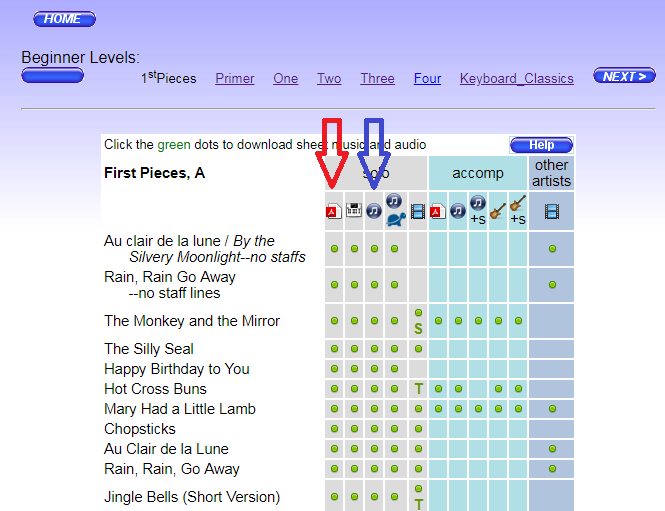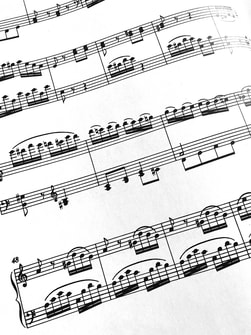
Transcribing isn't something we often think about doing in the "classical" world, where most of our music is already available in written format and not just on recordings. However, I think that learning how to transcribe can have huge benefits for students of all musical genres. Transcribing helps students develop their rhythmic and melodic dictation skills; teaches them the rules of written notation; and trains their ears to listen, analyze, and understand the layers of information they are hearing in a recording. Transcribing is especially important for students that are interested in composition, since it will help them learn how to write down their own music more quickly and easily.
So, how can we develop this skill of transcribing from a very early level? I recently had an "a-ha" moment when I realized that one of my favorite public domain sheet music sites, G Major Music Theory, has mp3 files available for all of its pieces--even those at the beginner level. This means that students can listen to a recording of a simple piece, transcribe it on staff paper, and then check their work by looking at the sheet music for that piece. It is a perfect set-up for teaching students the basics of transcription!
Before my students do their first transcribing project, I make sure they have already done some rhythmic dictation practice, as well as a few of my ear training challenge worksheets found HERE. This gives them a good foundation so that the transcribing process isn't overwhelming. Once they have a few of those ear training activities under their belt, they are ready to transcribe!
Here is how my students have been learning to transcribe in their lessons:
1) Get your blank staff paper ready. I like the staff paper variety pack that Susan Paradis makes available on her website for free HERE. It makes it easy to choose the right size depending on the age and skill level of your student. (It can also be helpful for students to have blank scratch paper ready, so they can take notes on what they hear before they write on the staff--more on that later!)
2) Go to the G Major Music Theory website and find the free piano music archives HERE. The various sheet music levels are listed across the top of the page. The easiest level looks like this:
The red arrow in the screenshot above points to the link for the PDF sheet music of each piece; the blue arrow points to the link for the mp3 of each piece. Many of the pieces also have a slower version of the mp3 available (look for the turtle symbol).
3) Choose a piece for your student to transcribe. Here are my suggestions of pieces that have worked well for my students:
Easiest pieces HERE (using treble clef only, C through G, quarter, half and whole notes):
- Au Clair de la Lune
- Do, Do, L'Enfant Do
- Go Tell Aunt Rhody
- Fais Dodo (3/4 time)
Slightly more difficult pieces HERE (melody only, treble and bass clefs, an octave range or less, includes eighth note pairs)
- Five Fat Turkeys are We
- Yonder She Comes
- Down Came a Lady
- Gray Squirrel
Songs with simple harmony (fifths or primary chords only) HERE
- Lazy Mary (under level 2A): keys of C, F, G, and D major available
- Land of the Silver Birch (under level 2B): D minor with fifths only in LH
- Good Morning (under level 2C): key of C, 3/4 time, melody switches from treble to bass clef, and there is a pick-up note)
Song in 6/8 time, using primary chords, available in a variety of major keys
- Little Sir Echo (under level 3A HERE)
4) Listen, listen, and listen again! I tell my students to listen to a piece several times, focusing on one element at a time. For students new to transcribing, it can be helpful to first write the rhythms and letter names on a blank piece of paper, then transfer everything to the staff.
- Rhythm: what is the time signature? Can you write out the rhythm notes you hear? Do any of the rhythmic patterns repeat?
- Notes: what is the key signature? Can you play the melody you hear on the piano? Can you write down each melody note above the rhythm notes you wrote down? Do any of the melodic patterns repeat?
- Harmony: what harmonies do you hear? Can you label these in the music (either on your scratch paper, or above the appropriate measure on your staff paper)?
5) Transfer your notes to the staff paper. Once students have listened to the piece and understand the overall rhythmic, melodic, and harmonic structure, they are ready to write on the staff. Once everything is written on staff paper, do one final listen to make sure everything looks correct.
6) Once your student has everything transcribed on the staff, check the transcription against the sheet music. Were they right? Don't forget to check for correct notation, too--for example, are your stems pointing in the correct direction? Are your clefs, key signature, and time signature drawn correctly?
Transcribing takes a bit of practice, but after transcribing a few short pieces you should be able to tell a big difference in your students' listening and notation skills.
What do you think? Do you have your students transcribe from recordings? Do you think learning to transcribe is beneficial? I'd love to hear your thoughts in the comments!



 RSS Feed
RSS Feed